ISS: TSIS (Total and Spectral solar Irradiance Sensor)
EO
Atmosphere
Radiation budget
NASA
The ISS/TSIS (International Space Station/Total and Spectral Solar Irradiance Sensor) is an instrument onboard the ISS which measures solar irradiance. Launched in December 2017, it is operated by NASA Goddard Space Flight Centre. Its expected end of life is March 2023, when it will be replaced by TSIS-2, a free-flying satellite.
Quick facts
Overview
| Mission type | EO |
| Agency | NASA |
| Mission status | Operational (extended) |
| Launch date | 17 Dec 2017 |
| Measurement domain | Atmosphere |
| Measurement category | Radiation budget |
| Measurement detailed | Downwelling (Incoming) solar radiation at TOA |
| Instruments | TSIS-1/SIM, TSIS-1/TIM |
| Instrument type | Earth radiation budget radiometers |
| CEOS EO Handbook | See ISS: TSIS (Total and Spectral solar Irradiance Sensor) summary |
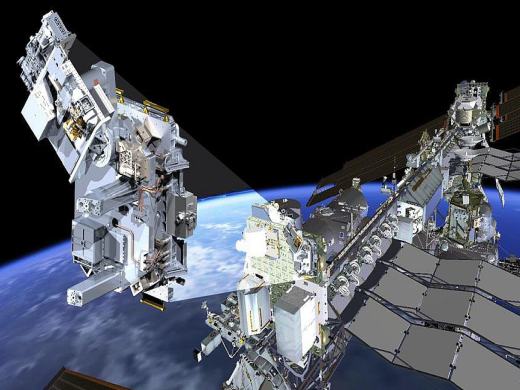
Summary
Mission Capabilities
The TSIS provides a continuation of the TSI data from the previous NASA Solar Radiation and Climate Experiment (SORCE) mission. It consists of the Total Irradiance Monitor (TIM) and the Spectral Irradiance Monitor (SIM) which are upgraded versions of those flying on the SORCE mission.
TIM measures the total amount of light energy emitted by the sun and SIM measures the distribution of solar energy over ultraviolet, visible, and infrared regions of light. These measurements are critical to observe the effect of different wavelengths on different parts of the atmosphere. Together, these highly accurate and stable measurements can be used to portray a better understanding of Earth’s primary energy supply and provide information to predict the future climate. Solar irradiance is considered to be the most fundamental climate data record derived from space-based observations.
Performance Specifications
TSIS follows a non-sun-synchronous orbit, inclined at 51.6° at an altitude of 407 km and a period of 93 minutes. Both monitors provide 15 measurements per day.
TIM provides 7 configurations. It measures TSI incident at the outer boundaries of the atmosphere. Its estimated uncertainties are around 160 ppm.
SIM provides 13 configurations. It measures Solar Spectral Irradiation from 200 – 2400 nm (96% of TSI). For the range of 200-460 nm uncertainties are at 0.42%, dropping 0.24% for the range of 460-2400nm.
Space and Hardware Components
TSIS rides onboard the International Space Station, where it is mounted on the ExPRESS Logistics Carrier-3 atop a Three Axis Deployment system. As the system is designed for a five-year mission, TSIS-2 aims to replace it in 2023.
ISS Utilization: TSIS(Total and Spectral solar Irradiance Sensor)
TSIS Instrument Launch Mission Status References
The TSIS instrument, first selected in 1998 for the NPOESS (National Polar-orbiting Operational Environmental Satellite System) mission, re-manifested in 2010 on the NOAA-NASA JPSS (Joint Polar Satellite System) mission, then on the NOAA Polar Free Flyer, is now (2015) scheduled to be implemented as part of the newly established SIDAR (Solar Irradiance, Data and Rescue) program with a launch planned in 2017 to the ISS (International Space Station). 1) 2)
The objective of TSIS is to acquire measurements of total and spectral solar irradiance (TSI and SSI, respectively). TSI (Total Solar Irradiance) is required for establishing Earth’s total energy input while SSI (Solar Spectral Irradiance) is needed to understand how the atmosphere responds to changes in the sun’s output. Solar irradiance is one of the longest and most fundamental of all climate data records derived from space-based observations.
TSIS provides continuation of the TIM (Total Irradiance Monitor) and the SIM (Spectral Irradiance Monitor), currently flying on the NASA SORCE (Solar Radiation and Climate Experiment) mission. Launched in 2003, SORCE is now more than six years beyond its prime-mission lifetime. The launch failure of the NASA Glory mission in 2011, coupled with diminished battery capacity on SORCE and delays in the launch of TSIS, have put the continuous 36-year TSI record at risk. In 2012, a plan to maintain continuity of the TSI calibration scale between SORCE and TSIS was rapidly implemented through the USAF Space Test Program STPSat-3 that launched in late 2013. The shorter SSI record faces a likely gap between SORCE and TSIS.
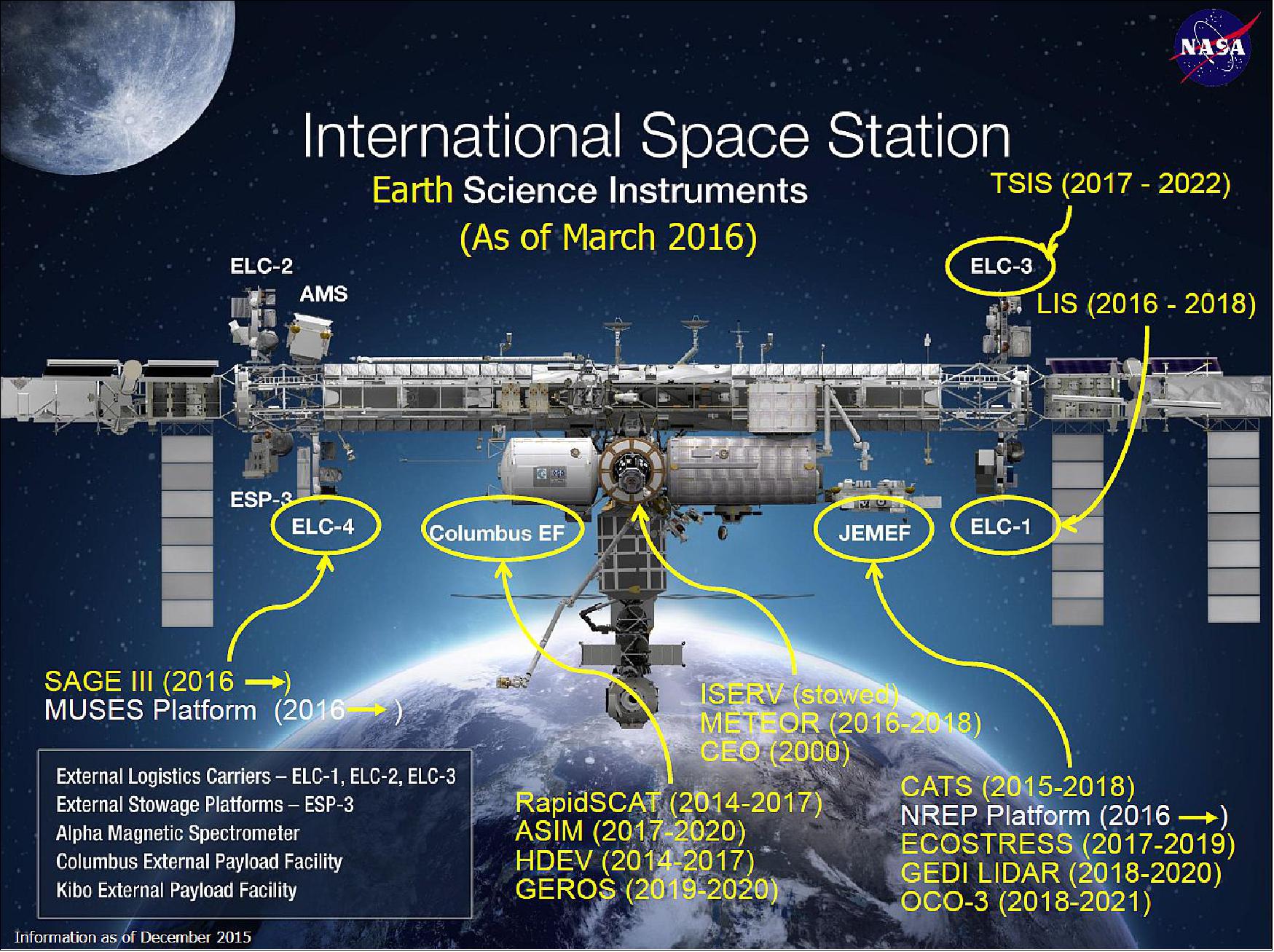
Development Status
• August 3, 2020: General Atomics Electromagnetic Systems (GA-EMS) won a $32.9 million contract to build NASA’s Total and Spectral solar Irradiance-2 (TSIS-2) spacecraft, a small satellite scheduled to launch in 2023. 4)
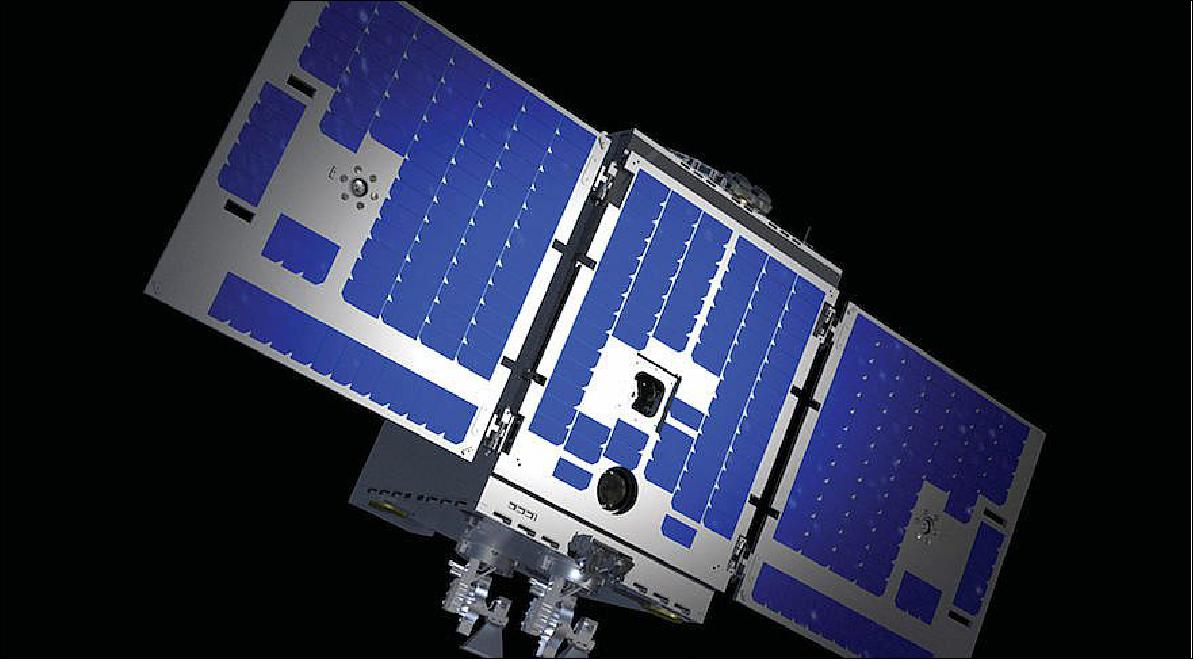
- Under the firm-fixed price, time and materials contract awarded July 6, General Atomics will develop and test the TSIS-2 spacecraft, integrate instruments, and support the launch and in-orbit operations for three years. TSIS-2 will be equipped with the Total Irradiance Monitor and Spectral the Irradiance Monitor built by the University of Colorado Laboratory for Atmospheric and Space Physics.
- “TSIS-2 will observe the sun and its evolution over time to better inform climate models and improve understanding of solar events,” Nick Bucci, vice president of GA-EMS Missile Defense and Space Systems, told SpaceNews.
- General Atomics is basing the TSIS-2 design on its Orbital Test Bed, a scalable, modular platform designed to accommodate multiple payloads from a single customer or hosted payloads from multiple customers.
- General Atomics plans to design, manufacture, assemble, integrate and test the TSIS-2 satellite at its existing facilities in the Denver area and at its new spacecraft development, integration and test factory in Centennial, Colorado, Bucci said in an interview.
- The first Orbital Test Bed, which launched in 2019 on a SpaceX Falcon Heavy, housed five distinct payloads for commercial, government and academic customers, including the Deep Space Atomic Clock developed by the NASA Jet Propulsion Laboratory.
• April 20, 2020: NASA has awarded a sole source contract to the Laboratory for Atmospheric and Space Physics (LASP) at the University of Colorado Boulder for the Total and Spectral Solar Irradiance Sensor-2 (TSIS-2). The new sensor provides continuity to data delivered by TSIS-1, which launched in December 2017. 5)
- This is a cost-no-fee contract in the amount of $18,044,280 with a period of performance ending with on-orbit acceptance by the government. This action definitizes a letter contract that was issued on August 6, 2019.
- Under this contract, the LASP will provide two instruments – the Total Irradiance Monitor (TIM) and the Spectral Irradiance Monitor (SIM). LASP will also provide all necessary support to integrate and test these instruments with the spacecraft, including all post-launch activities leading to commissioning. LASP will also be responsible for the establishment of the TSIS-2 Science Operations Center (TSOC). These instruments are nearly identical to those currently in operation on the predecessor TSIS-1 mission.
- The TIM will continue to provide a 40-year uninterrupted measurement record of the Total Solar Irradiance (TSI) which is the Earth’s predominant energy source. The SIM will continue to measure the Solar Spectral Irradiance (SSI) and identify the regions in Earth’s atmosphere and surface that are affected by solar variability.
- This is a directed mission to address the 2017 Decadal Survey recommendation for sustained multidecadal global measurements of solar irradiance and will continue the collection of high-quality data for the long-term climate record. These measurements are indispensable to the scientific community for understanding solar influences on the Earth’s climate.
- While TSIS-1 was a hosted payload on the International Space Station (ISS), TSIS-2 is a free flying satellite. NASA contracted in July 2020 with General Atomics Electromagnetic Systems (GA-EMS) for the construction of the satellite, based on the OTB-2 platform. General Atomics will develop and test the core spacecraft for the TSIS-2 project, integrate the primary instrument into the observatory, and provide the functional, performance and environmental testing of the observatory. They will also ship the spacecraft to the launch site and support launch operations, in-orbit performance verification and operations of the mission operations center for three years, through the decommissioning of the TSIS-2 spacecraft.
• August 4, 2017: The TESIS-1 instrument has arrived at NASA/KSC (Kennedy Space Center) for a targeted December launch. 6)
• University of Colorado is upgrading existing chamber for TSIS-1 thermal vacuum testing.
• NASA assumed responsibility for TSIS-1 as of October 1, 2015. The TSIS-1 project (and LASP contract) are funded.
• A TSIS-1 delta-Critical Design Review was successfully completed July 2015.
• A NASA decision to accommodate TSIS-1 on the ISS (International Space Station) was provided in April 2014.
• A portion of the TSIS-1 sensors were already fabricated over the years; they are in storage at CU/LASP (Figure 3).

Science Objectives:
• Nominal five-year mission, provides continuation of TSI record from SORCE and USAF STPSat-3
• Quantify variability in incoming solar radiation, as the most precise indicator for changes in Sun’s energy output
• Determine regions/layers of Earth’s atmosphere that are affected by solar variability, in order to quantify solar forcing mechanisms causing changes in climate
• Determination of whether the Sun’s spectral ultraviolet output is in- or out-of-phase with visible wavelength output
• Provision of TSI and SSI data to support community science in climate, atmosphere, solar physics, and radiative transfer modeling.

Figure 4: Total and spectral solar irradiance missions of NASA and NOAA (image credit: NOAA, NASA, Ref. 2)
Overview of TSIS-1 mission responsibilities 7)
• NASA/GSFC (Goddard Space Flight Center), Greenbelt, Maryland:
- TSIS-1 project: project management, system engineering, safety and mission assurance, and engineering oversight for the TSIS-1 payload
- ESDIS (Earth Science Data and Information System) Project/GES DISC (Goddard Earth Sciences Data and Information Services Center): archive and distribution for TSIS-1 data
• University of Colorado CU/LASP (Laboratory for Atmospheric and Space Physics), Boulder, CO:
- Design, development and testing of TSIS-1, support for ISS integration, science operations of the TSIS-1 instrument, data processing, data evaluation and delivery to the GES DISC
- TSIS-1 Science Operations Center, TSIS-1 Science Data System
• International Space Station Program:
- Launch services and robotic installation of the TSIS-1 payload onto an ISS Express Logistics Carrier (ELC-3), mission operations, and communications
- ISS interface: ISS POIC (Payload Operations Integration Center), Huntsville Operations Support Center, AL.
The TSIS-1 mission is planned for an operational period of 5 years with solar tracking during sunlit phases.
• TIM (Total Irradiance Monitor) provides 7 configurations. TIM measures TSI incident at outer boundaries of atmosphere.
• SIM (Spectral Irradiance Monitor) provides 13 configurations. SIM measures SSI from 200 – 2400 nm (96% of TSI).
Mounted on the ELC-3 (ExPRESS Logistics Carrier 3), TSIS will acquire measurements of total and spectral solar irradiance (TSI and SSI, respectively). TSI is required for establishing Earth’s total energy input while SSI is needed to understand how the atmosphere responds to changes in the sun’s output. Solar irradiance is one of the longest and most fundamental of all climate data records derived from space-based observations.
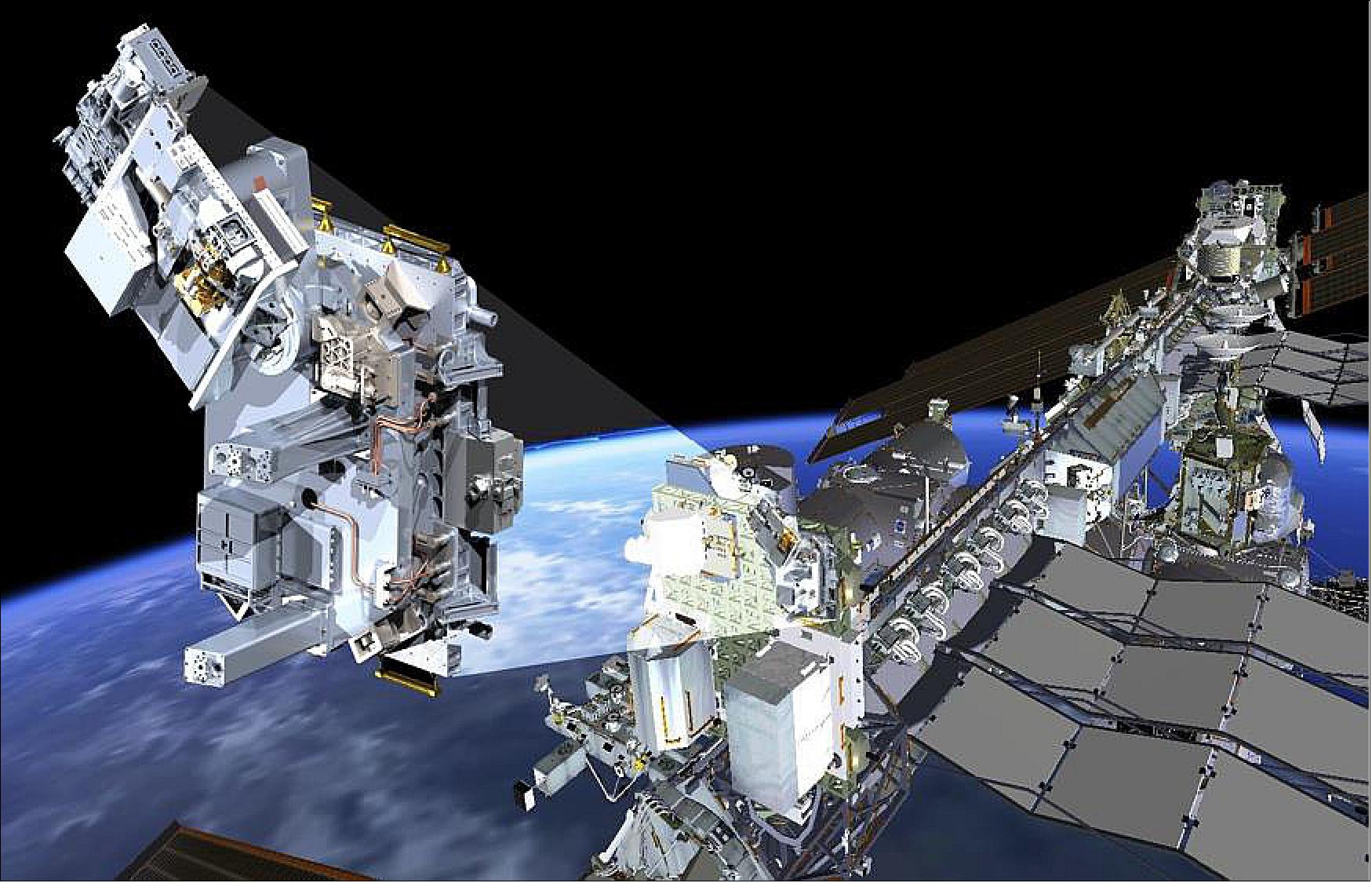
Legend to Figure 5: The TSIS TPS (Thermal Pointing System) is deployed above the ELC-3 location after installation in order to provide sufficient clearance to track the sun each orbit with a two-axis gimbal.
TSIS (Total and Spectral solar Irradiance Sensor) Instrument
In early 2014, NOAA and NASA agreed to fly TSIS on the ISS (International Space Station). In the FY16 President’s Budget, NASA assumes responsibility for the TSIS mission on ISS (Ref. 7).
The TSIS-1 TIM and SIM instruments are upgraded versions of the two instruments that are flying on the SORCE (Solar Radiation and Climate Experiment) mission.
TSIS-1 is needed on-orbit as soon as practical to provide total and spectral solar irradiance measurements needed to maintain 35+ year climate data record continuity:
- Solar irradiance data record is critical for determining solar influences on Earth climate
- SORCE (Solar Radiation and Climate Experiment), launched in 2003 with a 5-year design life, currently provides these measurements
- Total Solar Irradiance Calibration Transfer Experiment (TCTE), built from “spare parts” and launched November 2013 on Air Force Space Test Program Satellite (STPSat-3, 2-3 year design life), will provide calibration between SORCE and TSIS-1 total solar irradiance measurements.



Launch
TSIS-1 was launched on 15 December 2017 (15:36 UTC) on the SpaceX-13 Falcon 9FT vehicle in a Dragon trunk as an unpressurized payload. The launch site was the Cape Canaveral Air Force Station, SLC-40 (Space Launch Complex 40). 9) 10)
Orbit: Near-circular orbit of the ISS, altitude of ~400 km, inclination = 51.6º, period = 93 minutes.
This mission marks the first time SpaceX has flown both a flight-proven Falcon 9 and a flight-proven Dragon spacecraft in the same mission. Falcon 9’s first stage previously supported the CRS-11 mission in June 2017 and the Dragon spacecraft previously supported the CRS-6 mission in April 2015.
Mission Status
• June 4, 2020: The current implementation for continuous, long-term solar spectral irradiance (SSI) monitoring is the Total and Spectral Solar Irradiance Sensor (TSIS-1) Spectral Irradiance Monitor (SIM) that began operations from the International Space Station (ISS) in March 2018 and nominally provides an SSI spectrum every 12 h. Advances in both instrument design and spectral irradiance calibration techniques have resulted in the TSIS-1 SIM achieving higher absolute accuracy than its predecessor instrument in the wavelength range (200–2400 nm). A comprehensive detector-based Spectral Radiometer Facility (SRF) was developed in collaboration with the US National Institute for Standards and Technology (NIST) to ensure the ties to spectral SI standards in power and irradiance. Traceability is achieved via direct laser calibration of a focal plane electrical substitution radiometer (ESR) against a cryogenic radiometer in power and also irradiance responsivity via calibrated apertures. The SIM accuracy definition followed an absolute sensor approach based on a full radiometric measurement equation where component-level performance characterizations and calibrations were quantified with an associated uncertainty error budget and verified by independent measurements for each parameter. Unit-level characterizations were completed over the full operational envelope of external driving factors (e.g., pointing and temperature ranges) and were allowed for the independent parameterization of subassembly performance for expected operating conditions. Validation and final instrument end-to-end absolute calibration in the Laboratory for Atmospheric and Space Physics (LASP)-SRF achieved low combined standard uncertainty (uc < 0.25%, k = 1) in spectral irradiance. 11)

• October 2019: TSIS-1 continues to produce high quality solar irradiance data from the International Space Station. TSIS is currently midway through the second year of its five-year prime mission. Preparations for TSIS-2 have already begun, with a launch-readiness date of February 2023. 12)
- TSIS-1 acquires measurements of total and spectral solar irradiance (TSI and SSI, respectively). TSI is required for establishing Earth’s total energy input, while SSI is needed to understand how the atmosphere responds to changes in the sun’s output.
• March 15, 2018: NASA has powered on its latest space payload to continue long-term measurements of the Sun's incoming energy. Total and Spectral solar Irradiance Sensor (TSIS-1), installed on the International Space Station, became fully operational with all instruments collecting science data as of this March. 13)
- "TSIS-1 extends a long data record that helps us understand the Sun’s influence on Earth’s radiation budget, ozone layer, atmospheric circulation, and ecosystems, and the effects that solar variability has on the Earth system and climate change," said Dong Wu, TSIS-1 project scientist at NASA's Goddard Space Flight Center in Greenbelt, Maryland.
- For over two months, the operations team at the University of Colorado LASP (Laboratory for Atmospheric and Space Physics) in Boulder, Colorado have been testing TSIS-1. First, the team tested the all-important pointing platform that directs the solar instruments at the Sun.
- Next came testing of the solar instruments. TSIS-1 studies the total amount of light energy emitted by the Sun using TIM (Total Irradiance Monitor), one of two sensors onboard. This sensor's data will give us a better understanding of Earth’s primary energy supply and provide information to help improve models simulating the planet’s climate. The monitor first started collecting science data – called "first light"— on January 11th after its doors were opened to fully view the Sun. The sensor extends a 40-year measurement of the Sun's total energy to Earth.
- The second onboard sensor, called SIM (Spectral Irradiance Monitor), measures how the Sun’s energy is distributed over the ultraviolet, visible and infrared regions of light. Measuring the distribution of the Sun's energy is important because each wavelength of light interacts with Earth's atmosphere differently.
- For instance, spectral irradiance measurements of the Sun's ultraviolet radiation are critical to understanding the ozone layer — Earth's natural sunscreen that protects life from harmful radiation. The sensor experienced first light on March 4th when full science data collection began. TSIS-1's Spectral Irradiance Monitor extends a 15-year record of spectral irradiance measurements.
- "All systems are operating within their expected ranges," said Peter Pilewskie, TSIS-1 lead scientist LASP. "A lot of hard work remains for the team to interpret and validate the TSIS-1 data."
- NASA/GSFC (Goddard Space Flight Center) has overall responsibility for the development and operation of TSIS-1 on the International Space Station for the next 5 years. LASP under contract with NASA, is responsible for providing the solar irradiance measurements and providing them to the Goddard Earth Science Data and Information Services Center, the archive and distribution center for TSIS-1 data, so they are available to the scientific community.
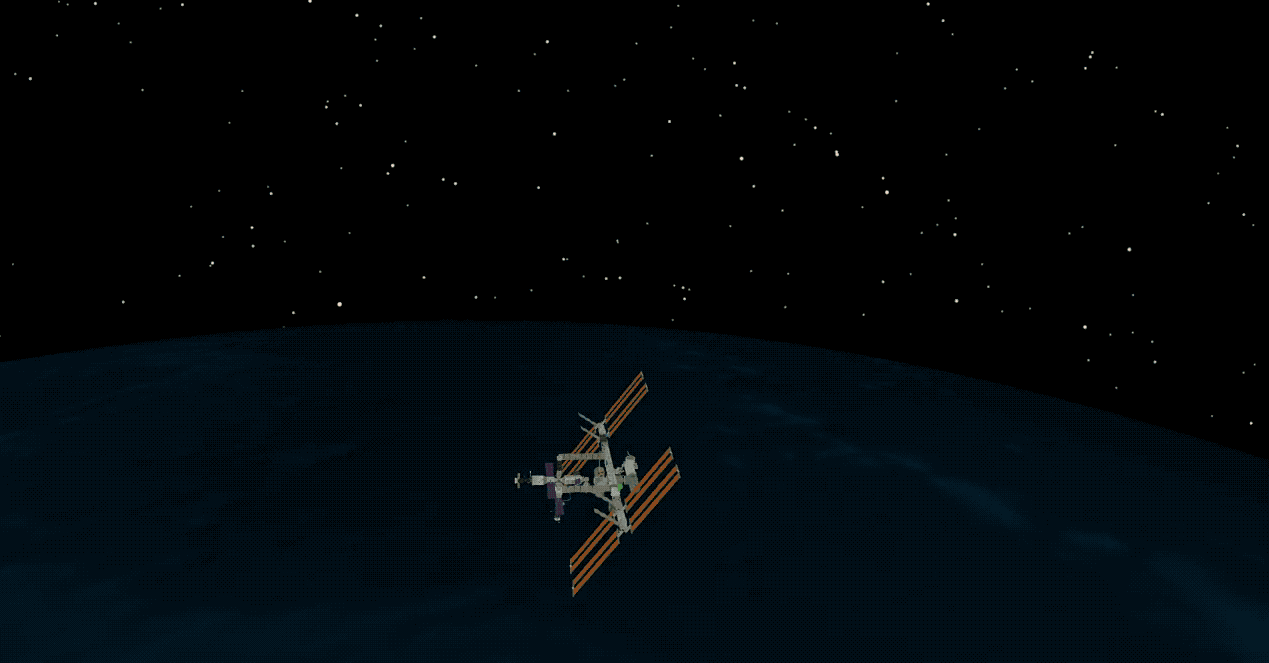
• February 14, 2018: NASA has awarded a contract to LASP (Laboratory for Atmospheric and Space Physics) at the University of Colorado Boulder, for mission operations and data processing for the agency’s TSIS-1 (Total and Spectral solar Irradiance Sensor-1). 14)
- This is a cost-no-fee completion contract, with a phase-in period of 29 days, followed by a one-year base period and four one-year options. The total maximum value of the contract is approximately $16.2 million. All work will be performed at the University of Colorado Boulder.
- The contractor will process, manage, analyze and deliver TSIS-1 science data products and develop TSIS-1 command procedures, scripts and command uploads for on-orbit operations.
- TSIS-1 will see tiny changes in solar irradiance, providing a key input data set for scientists to use in their study of the Sun's natural influence on Earth's ozone layer, atmospheric circulation, clouds, and vegetation. Solar irradiance is one of the most fundamental of all space-based climate data records and, for that reason, scientists have measured TSI from space since 1978 to help quantify the role of changes on the Sun in climate change. TSIS-1 will provide the most accurate measurements of sunlight to date and continue the long-term climate data record.
• On 30 December 2017, the TSIS-1 instrument was successfully installed on the ExPRESS Logistics Carrier (ELC), and is currently conducting checkout operations.
• The SpaceX CRS-13 Dragon cargo spacecraft was installed on the Harmony module of the ISS on 17 Dec. 2017 at 8:26 a.m. EST or13:26 GMT (Ref. 16).
- The 13th contracted commercial resupply mission from SpaceX (CRS-13) delivered 2205 kg of supplies and payloads to the station. This includes 490 kg of supplies and provisions for the crew, 711 kg of scientific equipment and experiments, 189 kg of space station hardware, 5 kg of computer equipment and 165 kg of hardware to support EVAs (Extra-Vehicular Activities), or spacewalks, from the station.
Two unpressurized payloads, with a combined mass of 645 kg, are contained within Dragon’s Trunk.
1) SDS ( Space Debris Sensor) will be mounted to the outside of the Columbus laboratory. With a surface area of 1 m2, it will detect impacts from small pieces of orbital debris measuring as small as 50 µm across. SDS will operate at the station for at least two years, recording the velocity and size of objects that impact it.
2) TSIS-1 (Total and Spectral Solar Irradiance Sensor-1) will be mounted on the station’s ELC-3 (ExPRESS Logistics Carrier-3) platform, which is attached to the station’s P3 port truss segment. TSIS-1, will measure the Sun's energy input to Earth. TSIS-1 measurements will be three times more accurate than previous capabilities, enabling scientists to study the Sun’s natural influence on Earth’s ozone, atmospheric circulation, clouds and ecosystems.
- Research materials flying inside Dragon's pressurized area include an investigation demonstrating the benefits of manufacturing fiber optic filaments in a microgravity environment. Designed by the company Made in Space, and sponsored by CASIS (Center for the Advancement of Science in Space), the investigation will attempt to pull fiber optic wire from ZBLAN, a heavy metal fluoride glass commonly used to make fiber optic glass. Results from this investigation could lead to the production of higher-quality fiber optic products for use in space and on Earth.
- Dragon is scheduled to depart the station in January 2018 and return to Earth with more than 1630 kg of research, hardware and crew supplies.
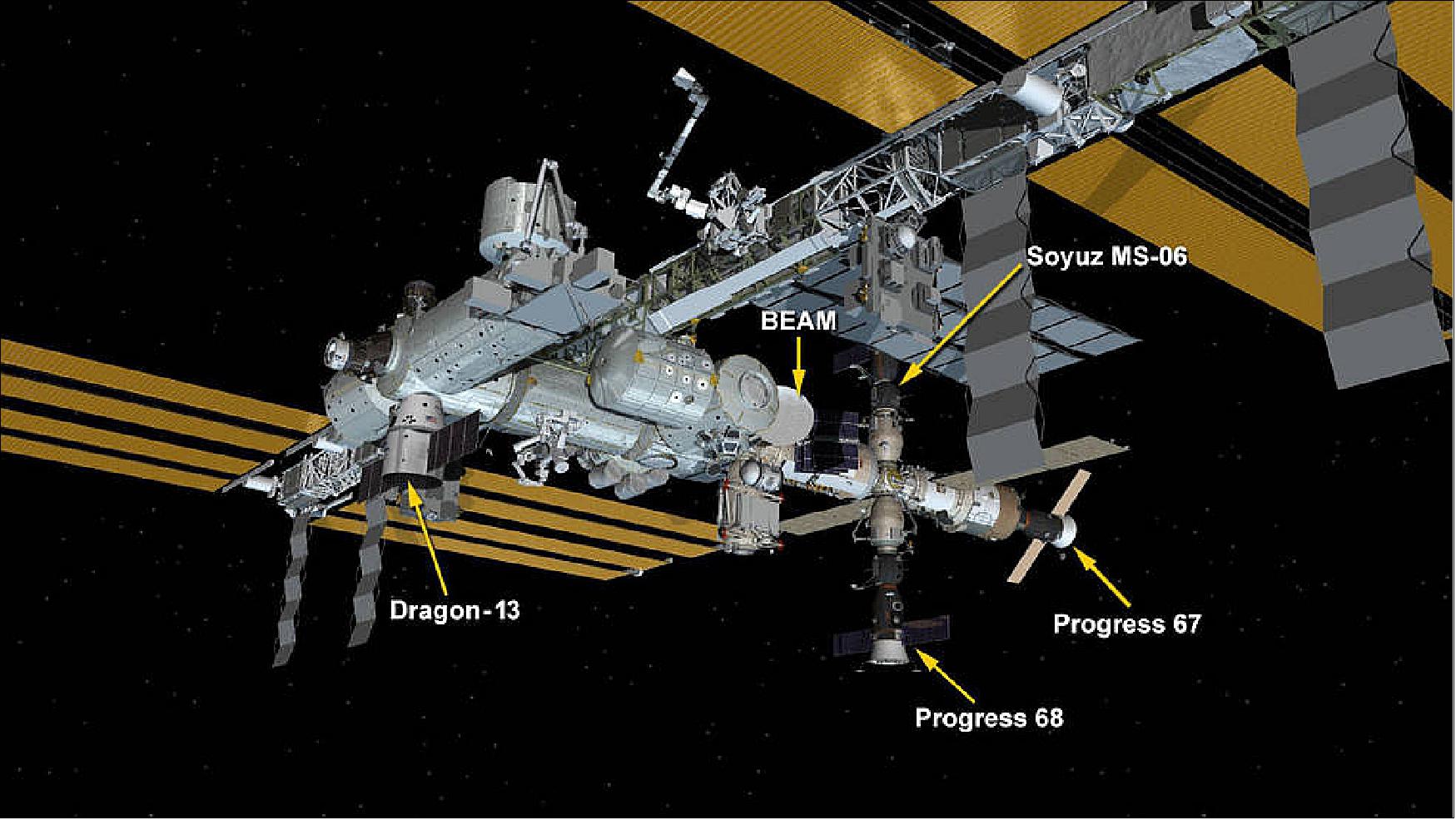
• While to ISS was traveling overhead between Australia and Papua New Guinea, NASA astronauts Mark Vande Hei and Joe Acaba captured the Dragon spacecraft on 17 Dec. 2017 at 5:57 a.m. EST (9:57 GMT) using the space station’s robotic arm. 16) 17)
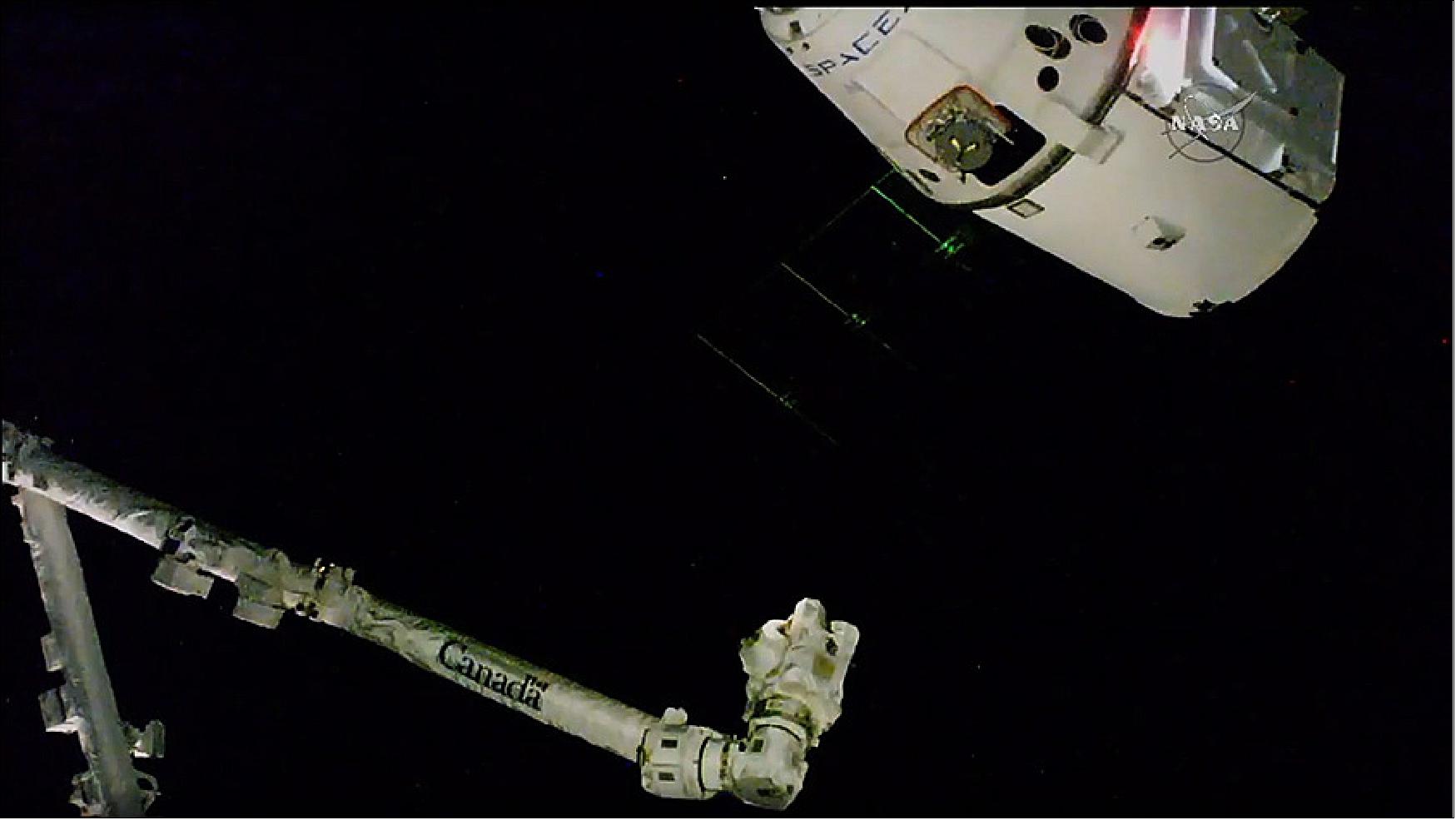
References
1) ”Quick Facts: Total and Spectral Solar Irradiance Sensor (TSIS),” CU/LASP (University of Colorado/ Laboratory for Atmospheric and Space Physics), 2015, URL: http://lasp.colorado.edu
/home/missions-projects/quick-facts-tsis/
2) Dan Mamula, ”NOAA Solar Irradiance Data and Rescue (SIDAR) Program,” NOAA, April 30, 2015, URL: http://satelliteconferences.noaa.gov/2015/doc/presentation
/Session%204/4.3d_NSC2015_Session_4.3d_Mamula.pdf
3) Julie A. Robinson, William L. Stefanov,”Earth Science Research on the International Space Station,” Committee on Earth Science and Applications from Space (CESAS) Space Studies Board National Academies of Science, Engineering, Medicine, 29 March 2016, URL: http://sites.nationalacademies.org/cs/groups/ssbsite/documents/webpage/ssb_171788.pdf
4) Debra Werner, ”NASA taps General Atomics to build solar irradiance satellite,” SpaceNews, 3 August 2020, URL: https://spacenews.com/nasa-taps-general-atomics-to-build-solar-irradiance-satellite/
5) ”NASA Awards Total and Spectral Solar Irradiance Sensor-2 Contract,” NASA Contract Release 20-009, 20 April 2020, URL: https://www.nasa.gov/press-release/goddard/2020/
nasa-awards-total-and-spectral-solar-irradiance-sensor-2-contract
6) ”TSIS shipped to Kennedy Space Center for upcoming launch,” LASP, 4 Aug. 2017, URL: http://lasp.colorado.edu/home/blog/2017/08/04/
tsis-shipped-to-kennedy-space-center-for-upcoming-launch/
7) Candace Carlisle, ”Total and Spectral solar Irradiance Sensor (TSIS-1) Project Overview, ” 2015 Sun-Climate Symposium, Savannah, Georgia, USA, Nov. 10-13, 2015 URL: http://lasp.colorado.edu/media/projects/SORCE/meetings/2015/
presentations/Session%207/e_Carlisle_TSIS_Overview_Savannah2015.pdf
8) Kasha Patel, ”Four Decades and Counting: New NASA Instrument Continues Measuring Solar Energy Input to Earth,” NASA, 28 Nov. 2017, URL: https://www.nasa.gov/feature/goddard/2017
/four-decades-and-counting-new-nasa-instrument-continues-measuring-solar-energy-input
9) ”NASA Sends New Research to Space Station Aboard SpaceX Resupply Mission,” NASA Press Release 17-096, 15 Dec. 23017, URL: https://www.nasa.gov/press-release/
nasa-sends-new-research-to-space-station-aboard-spacex-resupply-mission
10) ”SpaceX Flight-Proven Falcon 9 and Dragon Successfully Head to ISS on Resupply Mission,” Satnews Daily, 15 Dec. 2017, URL: http://www.satnews.com/story.php?number=1159119243#
11) Erik Richard, Dave Harber, Odele Coddington, Ginger Drake, Joel Rutkowski, Matthew Triplett, Peter Pilewskie and Tom Woods, ”SI-traceable Spectral Irradiance Radiometric Characterization and Absolute Calibration of the TSIS-1 Spectral Irradiance Monitor (SIM),” Remote Sensing, Volume 12, Published: 4 June 2020, https://doi.org/10.3390/rs12111818
12) Steve Platnick, ”Editor's Corner” The Earth Observer, September – October 2019. Volume 31, Issue 5, page 2, URL: https://eospso.nasa.gov/sites/default/files/eo_pdfs/Sep_Oct_2019_color_508.pdf
13) Kasha Patel, Sara Blumberg, ”NASA Powers on New Instrument Staring at the Sun,”
14) ”NASA Awards Mission Operations, Data Processing Contract for Solar Energy Instrument,” PRNewswire, 14 Feb. 2018, URL: https://www.prnewswire.com/news-releases/
nasa-awards-mission-operations-data-processing-contract-for-solar-energy-instrument-300599016.html
15) ”Visiting Vehicle Launches, Arrivals and Departures,” NASA, 17 Dec. 2017, URL: https://www.nasa.gov/feature/visiting-vehicle-launches-arrivals-and-departures
16) Mark Garcia, ”Astronauts Capture Dragon Loaded With New Science,” NASA, 17 Dec. 2017, URL: https://blogs.nasa.gov/spacestation/
17) ”'Dragon back' as cargo reaches space station,” Space Daily, 17 Dec. 2017, URL: http://www.spacedaily.com/reports/Dragon_back_as_cargo_reaches_space_station_999.html
The information compiled and edited in this article was provided by Herbert J. Kramer from his documentation of: ”Observation of the Earth and Its Environment: Survey of Missions and Sensors” (Springer Verlag) as well as many other sources after the publication of the 4th edition in 2002. - Comments and corrections to this article are always welcome for further updates (eoportal@symbios.space.
TSIS Instrument Launch Mission Status References Back to Top